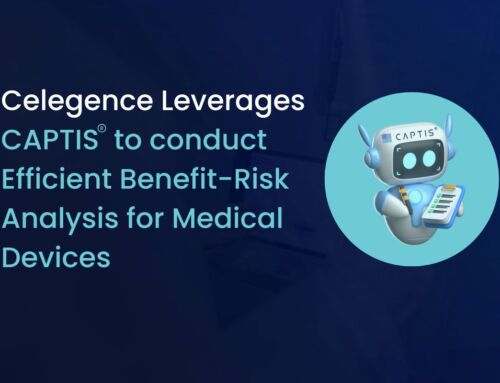
SaMD, Brexit & Market Surveillance – EUDAMED Database Webinar with John Bradsher
John Bradsher is a RAPS Global Certified expert in Regulatory Affairs and Quality Assurance of Medical Devices for Celegence. He has a background in the EU MDR that is both broad and deep: at a medium-sized manufacturer of vascular devices, he managed the program for MDR compliance, and in other assignments he managed the development of clinical evaluation documents for a global manufacturer. He has cleared several 510(k)s and has worked on products in EU classes I-III in his 27 years of project management.
With the European Commission delaying the implementation of EUDAMED, medical device companies now have an opportunity to be proactive. According to the EC, this new IT system aims to improve “transparency and coordination of information” for devices within the European marketplace.
During our webinar titled “How to Start Preparing your RA/QA Team for the EUDAMED Database”, John spoke specifically about which areas of EUDAMED require relevant changes by your staff, which areas will necessitate a regulatory partner, and helped attendees gain a broader understanding of the requirement timeline.
The following is the third in the series of blogs related to the “Celegence EUMDR Webinar – How to Start Preparing Your RA QA Team for The EUDAMED Database”. Read the 1st post about understanding EUDAMED and electronic systems. You can view the 2nd post about UDI and product types of immediate concern.
Why should you watch this video?
- To gain an understanding of the UDI requirement for Software as a Medical Device (SaMD)
- To learn more about the requirement for marketing in the UK Post-Brexit
- To understand the EUDAMED requirements for vigilance and post-market surveillance
A full transcript of Dr. John Bradsher’s talk is available to download (and to read below) and just press play to watch the clip now.

Claim Your Free EU MDR Checklist Now!
Make sure you and your business are compliant with the new EU MDR. Get our 23 page checklist for actionable technical documentation requirements.
Product Types: Software as a Medical Device (SaMD)
There are few product types that deserve special attention today, considering BUDI requirements, and I would like to talk about software as a medical device. As indicated here, the only software that is subject to UDI requirements are those that are commercially available on their own, or they constitute a standalone device.
If the software is an integral component of your device, such instances would be free from the UDI requirements. As indicated here, a new UDI is required in instances when you have a modification that changes the original performance, the software, or the interpretation of the data. It can also be required when you have either, any change that could result in misidentification of your device, or an ambiguity in its traceability.
Graphically, it is shown here, showing what could trigger a new UDI, which includes changes in your BUDI-DI, changes that impact performance and safety, or your interpretation of the data. Also, this includes changes to your trade name or other proper names, your version or model number, warnings or contraindications, and changes to the interface language.
Minor software changes, like bug fixes, would not rise to the level of requiring a new BUDI assignment, even though they would require a new product identifier of the UDI type (UDI-PI). However, if such a change rises to the level that it requires a security patch, or an enhancement to the operating efficiency of the software, it would be reverted to the UDI, triggering a major change, which would also be necessary to submit in a significant change note.

Marketing in the UK Post-Brexit
Many of you will be interested in marketing in the UK post-Brexit, and as we get closer to the end of 2020, it looks more likely that we may be dealing with a hard Brexit at the end of the year. As we discussed previously the MHRA has been providing guidance on this subject.
One of the things that will be introduced, is a new Conformity Assessment Mark, called the UKCA Mark. This will be a homolog, if you will, of the EU CE Mark for conforming devices. This will be necessary for those of you interested in marketing in the UK for all devices, after the midpoint of 2023, which is June 30th.
To obtain and to apply such a CE Mark, you are required to have a UK approved notified body, and an audit, in order to get the certificate and to fix the UKCA Mark on your labeling and device.
The MHRA has provided an allowance for those of you that may need a bit of time to comply with this requirement. Specifically, they are allowing manufacturers with current EU certificates that are either issued under the directive or the regulation – that is MDD and IVD, AIMDD, MDR or IVDR certificates – to remain valid in the UK, up to the mid-year point of 2023. So, we will have some time to comply with this regulation before it takes effect.
However, for new products that are going to be introduced to the UK after the end of 2020, these will now require separate audits and conformity assessments, except for products that are in class I self-declared groups.

Claim Your Free EU MDR Checklist Now!
Make sure you and your business are compliant with the new EU MDR. Get our 23 page checklist for actionable technical documentation requirements.
EUDAMED Module: Vigilance and Post-Market Surveillance System (Article 92, MDR; Article 87, IVDR)
Moving on to the remaining EUDAMED requirements, we have vigilance and post-market surveillance. This is your article 92 from the MDR obligation, and that correlates with the article 87 in the IVDR. This is where you will find reports of serious incidents and Field Safety Corrective Actions (FSCA) as described in articles 87, and 89. This is a good moment for us to remember that we are going to be on a shorter reporting time regime in the coming years. Specifically, we are currently at 30 days under the current MedDEV 2.1-2 guideline, and we will be moving to a 15-day reporting time for incidents and serious events effective on May 26th of 2021.
This includes legacy devices, and we should also note that the Field Safety Corrective Actions (FSCA) be reported without undue delay. This is also the module where you will find reports of trends and non-serious incidents, or expected undesirable side effects that could have a significant impact on the benefit risk analysis for devices.

Final Module of EUDAMED: The System on Market Surveillance (Article 100, MDR; Article 95, IVDR)
This brings us to the final module on EUDAMED, the system on Market Surveillance. This is the article 100 obligation, correlated to article 95 from the EU in-vitro diagnostic regulation. I regard this as the final module in the respect of the article numbers. However, it is expected to be one of the earliest available functional modules for manufacturers.
This is where you will find final inspection reports on economic operators in the supply chain, information on devices with an unacceptable profile risk to health and safety, information on noncompliant products, and information on preventative health measures. This will be a module accessed primarily by notified bodies, competent authorities, and the EU commission, but not the public. The only possible exception, would be information that is intended to promote public health protection.


